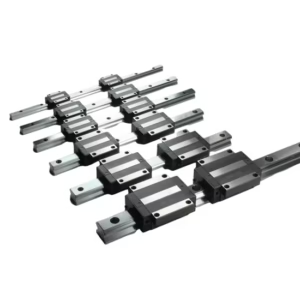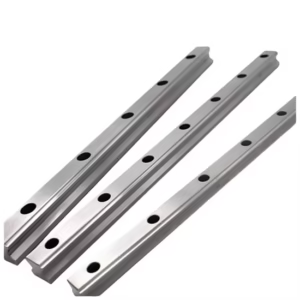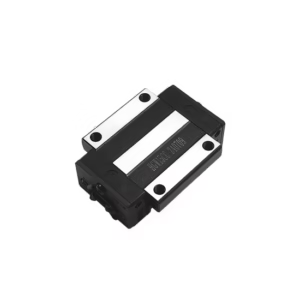Outline for Linear Guide Rail
| Main Topic | Subtopics |
|---|---|
| Introduction to Linear Guide Rail | Definition, Purpose in engineering, Historical background |
| How Linear Guide Rails Work | Basic principle, Rail and block mechanism, Friction reduction |
| Types of Linear Guide Rail | Profiled rail guides, Round rail guides, Roller-type guides, Ball-type guides |
| Materials in Linear Guide Rails | Hardened steel, Stainless steel, Coated rails, Polymer-based rails |
| Design Features of Linear Guide Rails | Load capacity, Rigidity, Accuracy, Durability |
| Advantages of Linear Guide Rail | High precision, Load-bearing capacity, Smooth motion, Long service life |
| Limitations of Linear Guide Rail | Cost, Installation complexity, Maintenance needs |
| Applications of Linear Guide Rail | CNC machines, Robotics, 3D printers, Aerospace, Medical equipment |
| Linear Guide Rail vs. Linear Bearings | Key differences, When to choose each |
| Linear Guide Rail vs. Round Shaft Systems | Comparison of performance, Applications |
| Choosing the Right Linear Guide Rail | Load requirements, Speed, Environment, Budget |
| Installation Guidelines | Mounting procedures, Alignment, Common mistakes |
| Maintenance of Linear Guide Rail | Cleaning, Lubrication, Inspection |
| Lubrication in Linear Guide Rail | Grease, Oil, Self-lubricating options |
| Friction and Wear in Linear Guide Rail | Causes, Solutions, Longevity improvements |
| Troubleshooting Linear Guide Rail Issues | Noise, Binding, Vibration, Wear |
| Linear Guide Rails in CNC Machines | Precision machining, Stability, Productivity |
| Linear Guide Rails in Robotics | Automation role, Accuracy, Case uses |
| Linear Guide Rails in 3D Printing | Smooth extrusion, Layer consistency, Print accuracy |
| Linear Guide Rails in Medical Equipment | Surgical robots, Imaging devices, Lab automation |
| Market Trends in Linear Guide Rail | Global demand, Key manufacturers, Innovation trends |
| Future of Linear Guide Rail | Smart sensors, IoT, Advanced coatings |
| DIY Projects Using Linear Guide Rails | CNC builds, Camera sliders, Custom robotics |
| Cost of Linear Guide Rails | Price ranges, Factors affecting costs, Alternatives |
| Eco-Friendly Aspects of Linear Guide Rails | Recyclability, Energy efficiency, Green lubricants |
| FAQs on Linear Guide Rail | Detailed common questions and answers |
| Conclusion on Linear Guide Rail | Final insights and outlook |
Introduction to Linear Guide Rail
A linear guide rail is a precision mechanical component designed to provide smooth, controlled, and accurate linear motion. Unlike simple sliding mechanisms, linear guide rails ensure that moving parts maintain rigidity, stability, and alignment even under heavy loads.
These rails consist of a rail and a carriage block that moves along it. The system reduces friction using rolling elements like balls or rollers, which makes them ideal for industrial machinery, robotics, aerospace systems, and 3D printing.
Historically, engineers relied on bronze bushings and sliding surfaces for linear motion, but these systems wore out quickly and required frequent lubrication. The introduction of ball and roller guide rails revolutionized motion systems, enabling machines to achieve higher accuracy, faster speeds, and longer service life.
How Linear Guide Rails Work
Linear guide rails work on the principle of rolling contact instead of sliding contact.
The rail is precisely machined for straightness and surface quality.
The carriage block contains rolling elements (balls or rollers).
When the block moves, the rolling elements circulate inside the block, reducing friction.
This design provides high rigidity and load capacity, ensuring precision motion in demanding applications.
Types of Linear Guide Rail

Profiled Rail Guides – Square or rectangular cross-section, excellent for rigidity and accuracy.
Round Rail Guides – Easier installation, less expensive, but less rigid.
Roller-Type Guides – Use rollers instead of balls, offering higher load capacity.
Ball-Type Guides – Use recirculating balls, offering high precision and smoothness.
Materials in Linear Guide Rails
Hardened Steel – High strength and long life.
Stainless Steel – Corrosion resistance for harsh environments.
Coated Rails – Surface treatments for wear resistance.
Polymer-Based Rails – Lightweight and low-cost for less demanding uses.
Design Features of Linear Guide Rails
Load Capacity – Handles heavy vertical and lateral loads.
Rigidity – Maintains accuracy under force.
High Accuracy – Precise machining for minimal deflection.
Durability – Long lifespan under continuous use.
Advantages of Linear Guide Rail
Exceptional precision in guiding motion.
Handles heavy loads without deformation.
Smooth, low-friction operation.
Long-lasting performance with proper care.
Limitations of Linear Guide Rail
Higher cost compared to simple bearings.
Complex installation requiring alignment.
Regular maintenance needed for best performance.
Applications of Linear Guide Rail
CNC Machines – Ensures cutting accuracy.
Robotics – Provides repeatable precision.
3D Printing – Smooth extrusion and consistency.
Aerospace – Navigation and testing systems.
Medical Devices – Surgical robots and imaging systems.
Linear Guide Rail vs. Linear Bearings
Guide Rails – Provide structure, rigidity, and support.
Linear Bearings – Focus on smooth motion but with less rigidity.
Linear Guide Rail vs. Round Shaft Systems

Guide Rails – More rigid and precise.
Round Shafts – Cheaper, easier to install, but less stable.
Choosing the Right Linear Guide Rail
Factors to consider:
Load requirements.
Speed of operation.
Environmental conditions (dust, humidity, cleanliness).
Budget and performance balance.
Installation Guidelines
Ensure precise alignment.
Use mounting bolts with correct torque.
Avoid forcing blocks onto misaligned rails.
Maintenance of Linear Guide Rail
Clean regularly to prevent dust buildup.
Lubricate periodically with grease or oil.
Inspect for wear on rolling elements.
Lubrication in Linear Guide Rail
Grease lubrication for durability.
Oil lubrication for high-speed movement.
Self-lubricating blocks for maintenance-free operation.
Friction and Wear in Linear Guide Rail
Caused by contamination, misalignment, or poor lubrication.
Reduced by proper maintenance and material selection.
Troubleshooting Linear Guide Rail Issues
Noise – Indicates poor lubrication.
Binding – Caused by misalignment.
Vibration – Signals uneven wear.
Excessive Wear – Suggests overloading.
Linear Guide Rails in CNC Machines
Provide stability and accuracy.
Essential for cutting precision.
Allow high-speed machining without losing accuracy.
Linear Guide Rails in Robotics
Enable automation precision.
Support repetitive, high-accuracy movement.
Critical for industrial robotic arms.
Linear Guide Rails in 3D Printing
Ensure consistent print quality.
Reduce layer misalignment.
Extend printer lifespan.
Linear Guide Rails in Medical Equipment

Applied in surgical robotics.
Essential in MRI and CT imaging devices.
Used in lab automation for accurate movement.
Market Trends in Linear Guide Rail
Increasing demand in automation and robotics.
Innovations in self-lubricating and smart rails.
Major players: THK, NSK, Bosch Rexroth, SKF.
Future of Linear Guide Rail
IoT-enabled smart monitoring.
Nanotechnology for ultra-precise rails.
Advanced coatings for longer lifespan.
DIY Projects Using Linear Guide Rails
Building CNC routers.
Designing camera sliders.
Creating robotic automation systems.
Cost of Linear Guide Rails
Standard rails: $50–$200.
High-performance rails: $300–$1,000.
Specialized rails: Thousands of dollars.
Eco-Friendly Aspects of Linear Guide Rails
Use of recyclable metals.
Reduced energy consumption through efficient design.
Adoption of green lubricants.
FAQs on Linear Guide Rail
What is a linear guide rail used for?
It provides stable, precise linear motion in machinery.
Do linear guide rails need lubrication?
Yes, lubrication is necessary unless self-lubricating designs are used.
What is the difference between a linear guide and a linear bearing?
A guide provides rigidity and support, while a bearing provides smooth motion.
Are linear guide rails expensive?
Prices vary from affordable to premium depending on type and application.
How long do linear guide rails last?
With proper maintenance, they can last for years even in demanding applications.
Which industries rely most on linear guide rails?
Manufacturing, robotics, aerospace, and healthcare.
Conclusion on Linear Guide Rail
A linear guide rail is far more than just a track—it is the foundation of precision motion in modern engineering. By combining strength, accuracy, and durability, linear guide rails empower industries to achieve automation, efficiency, and innovation.
As technology evolves, the integration of smart sensors, IoT connectivity, and advanced materials will shape the future of linear guide rails, ensuring they remain central to industrial progress and precision engineering.
Suggested Inbound Links
Guide to CNC Machines
Robotics Engineering Basics
Industrial Automation Systems

